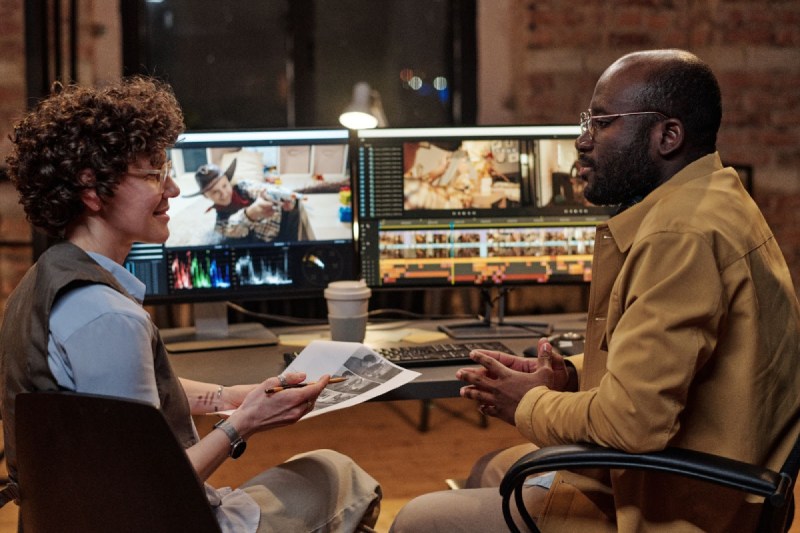
Motion graphics, a dynamic blend of graphic design and animation, have become essential in many industries, transforming how information and stories are conveyed visually. This vibrant field continues to evolve, influenced by technological advancements and creative exchanges that have expanded its reach and capabilities. From its historical roots in cinema to its modern digital media applications, motion graphics offer a compelling fusion of art and technology. Gabriel Collalto discusses how this fusion enhances storytelling and enriches user experiences, making it a continually relevant and evolving form of artistic expression.
Motion graphics blend graphic design and animation to create dynamic, engaging visual content. They are primarily used in media, advertising, and entertainment. This field, while modern in its current form, has roots deeply embedded in the history of cinema and traditional art. The concept began to take shape with early experiments in film and animation, where artists like Oskar Fischinger and Norman McLaren used motion to bring static images to life, setting the stage for what would eventually evolve into today’s sophisticated motion graphics.
The integration of motion graphics into mainstream media was significantly bolstered as television and advertising industries realized their potential to captivate audiences. This initial period of exploration and experimentation laid a robust foundation, allowing motion graphics to expand into a crucial element of visual storytelling and information distribution.
As technology advanced, so did the capabilities and complexity of motion graphics. The digital revolution of the late 20th century introduced tools and software that expanded creative boundaries, enabling designers to animate with unprecedented precision and creativity. This era marked a significant shift, transforming motion graphics from experimental art to an essential communication tool across various industries.
The advent of digital technology has profoundly influenced the landscape of motion graphics. Early software like Adobe After Effects and Autodesk Maya provided artists with new tools that enhanced precision and the ability to experiment with complex animations that were not possible before. These technologies streamlined motion graphics, making them more accessible to creators around the globe and allowing for a rapid expansion in the variety and sophistication of projects.
Over time, ongoing advancements in computing power and graphic design software have refined motion graphics capabilities. Artists can manipulate assets and complex digital environments today, creating intricate and realistic animations. This technological leap has enhanced the visual appeal of motion graphics and expanded their application beyond traditional media, influencing areas such as user interface design and virtual reality.
Cinema has witnessed several pivotal moments in which motion graphics have enhanced storytelling and set new standards for visual innovation. The title sequence of Alfred Hitchcock’s Psycho, designed by Saul Bass, is an early example of how motion graphics can effectively set the tone for a film. This integration of text and animation provided a new lens through which audiences could engage with cinematic narratives.
Another landmark project, James Cameron’s “Avatar,” pushed the boundaries of what motion graphics could achieve to create immersive experiences. The film’s use of 3D technology and motion capture to construct Pandora’s lush, alien world showcased how far the field had come and opened up new possibilities for future filmmakers. These projects serve as benchmarks in the industry, highlighting the creative and technological potential of motion graphics in storytelling.
Motion graphics today are shaped by a myriad of cultural influences that span across the globe. As artists and designers from various backgrounds share their unique perspectives, they infuse motion graphics with diverse aesthetics and techniques, enriching the field. This globalization of style has led to a vibrant, eclectic mix that reflects a fusion of traditions and modernity, evident in everything from commercial advertising to indie film production.
Emerging technologies such as artificial intelligence and virtual reality are set to play a pivotal role in the evolution of motion graphics. These tools offer exciting new creative avenues, allowing designers to create more immersive and interactive experiences. This ongoing innovation ensures that motion graphics will continue to be an exciting area of growth and innovation.
Dr. Rema Vassar is a leading advocate for equity in education, particularly in ensuring that… Read More
Exploring the world of guitar music is a journey into the heart of creativity, where… Read More
Marine construction is a vital field that shapes coastal infrastructure, energy production, and global connectivity.… Read More
The history of the United States is a story of resilience, transformation, and progress. From… Read More
Couples' financial planning helps them to realize their shared objectives and cohesive tactics, therefore turning… Read More
A Young Entrepreneur’s Visionary Talks with a Global Economic Leader Signal a Bold Future In… Read More